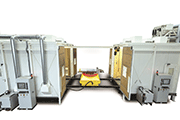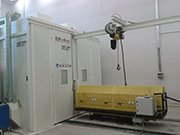E-Archive
Cover Page
in Vol. 16 - November Issue - Year 2015
"Unite and Conquer" - Implementation Of The Practical Aspect Into A Shot Peening System

Dual (ARSP+ARGB) robotic shot peening system

Robotically guided rotary nozzle system

Conveyor line between ARSP and ARGB peening cells

ITP (internal tube peening) system with lifting trolley

Double-pressure vessel for continuous peening

SCADA visualization of a robot processing cell
Shot peening applications always rely on optimally combining manipulation of work piece and the means for achieving the desired surface enhancement. This mutuality is especially challenging when distinct parts of one object require a different treatment. An example of such highly demanding task is shot peening of aircraft landing gear during its production or overhaul. Herein, we present a summary of conceptualization and realization of a specialized dual robot-controlled landing gear shot peening system from the personal perspective of Darko Hocevar, Technical manager at FerroCrtalic d.o.o.
Landing gear is one of the most delicate components of an aircraft, and any compromises in its functionality can quickly lead to a catastrophe. Therefore, the benefits, or rather the necessity, to utilize surface enhancement technology, especially shot peening applications, were realized already some time ago. As is many times the case, the objective of shot peening of landing gear components is much more clearly established in comparison to suitable means to achieve it. For instance, both air-blasting and wheel-blasting applications have been successfully implemented in the context of aerospace components surface treatment. Additionally, nowadays, shot peening required for 100% reliability of landing gear must induce controllable and repeatable plastic deformations in high-strength steel (HSS) parts as well as in more sensitive parts made of aluminium and titanium alloys. Thus, in addition to duality arising from accessibility of work piece surfaces, e.g. external and internal areas, the distinction in the required shot peening parameters for the different alloy parts contributes to the versatility of the operation. Most importantly, the main issues to consider at the start of conceptualization of novel landing gear shot peening systems were the needs to use different media and complex nozzle manipulation, as well as to address the particularities related to handling the work piece. After some time considering the most relevant parameters, especially their (in)compatibility and the fact that the task did not seem doable in the context of any individual shot blasting systems, we were circling around the concept of two separate processes. Luckily, soon enough, we realized that this could indeed be the key to the fresh design approach. Of course, implementation of all the requirements, e.g. computerization in accordance with SAE AMS2432 standard and strict instructions provided by the component manufacturers, was not straightforward. Nevertheless, without major inconvenience, we successfully held to the idea of a shot peening system exhibiting two stations, each equipped with a robot inside. Moreover, the cell for shot peening with ceramic or glass peening media and thus dedicated to lower intensity treatment that is compatible with the range of Almen N was designated ARGB.
In ARSP, which is the name given to the shot peening cell for performing higher intensity surface enhancement at the Almen A range, the process is based on peening with high specific gravity steel media. Essentially, the practical applicability of the dual peening system design is completely compatible with the full spectrum of the required shot peening treatment and propitiously complements the excellent productivity and efficiency. Moreover, the surface enhancement treatment repertoire includes peening of outside as well as inside diameters. One of the key elements was also coupling of the two individual systems through a conveyor. Along with connecting the separated shot peening cells, the conveyor also enables manipulation of workpieces that are initially loaded through an integrated lift. Notably, the synchronous servo rotary tables that are mounted on loading trolleys in either of the two cells provide an additional axis of movement with respect to the robotic manipulation. Synchronous drives of the rotary tables are regulated by specific robot control units. This is crucial also for the movement of the processing nozzles, which are controlled through 6-axis manipulator coupled with synchronous movement of the rotary tables altogether enabling shot peening performance through combination of linear and rotational directions. For this purpose, the conventional as well as the rotating nozzles must work interchangeably. One of the particularities of the novel dual system is that the rotating nozzle is held by a rotary lance, which, together with a small servomotor, assures adequate control over the nozzle rotation. In addition to shot peening inside rather small and shallow diameters, typically in the range of few tens and hundreds of millimetres respectively, the system must also cope with the surface treatment within the interior of up to 1.5m long cylindrical hollow parts. This is made possible by integrating a long rotating machining arm through an ITP (Internal Tube Peening) system.
The use of robotic manipulation in the systems such as the novel ARSP+ARGB was of course inevitable, notably not only due to requirement to follow SAE AMS2432 specifications. At this point, it would be unfair not to acknowledge performance of the ABB's industrial robots that perfectly integrate into the system and excellently play their role. Considering that the position repeatability and individual axis resolution are defined in the range of a few hundredths of millimetres and thousandths of degrees respectively, such performance can only be achieved by outstanding functionality of the robotic manipulation.
To ensure that the novel system is optimal and reliable over high throughputs, special care is addressed to controlling recovery of shot peening media, which includes utilization of cleaning and volume-classifying processes before automatic refilling of peening generators through pneumatic transportation. The refilling is done with the use of a double pressure blast generator thereby suppressing air pressure fluctuations and preventing inconvenient interruption of the process. In the context of machine processes, it seemed a rather natural choice to use modern SCADA system and thereby integrate very important and very practical benefits, such as advanced process visualization, simulations of operation, real-time monitoring and programming of parameters, and flexibility of servicing manipulations, etc. These and more are controlled through sophisticated PLC-controllers running through customized software that were specifically developed for this purpose and are one of the essential parts for managing the entire machining process.
Conclusion
The novel dual robotic shot peening system optimises the means to deal with demanding convoluted processes, such as overhaul of aircraft landing gears. In addition to exceptional quality of the technological process, the enhanced surface treatment application provides outstanding controllability and repeatability. The innovative design approach resulting in the dual shot peening system demonstrated the feasibility to consider all customer's as well as the complex peening requirements and incorporate them into a sophisticated, but nevertheless user-friendly and practical solution.
For Information:
FerroCrtalic d.o.o.
Sela pri Dolenjskih Toplicah 47
8350 Dolenjske Toplice, Slovenia
Tel. +386.7.38 45 100
Fax +386.7.38 45 115
E-mail: info@ferrocrtalic.com
www.ferroECOblast.com



























